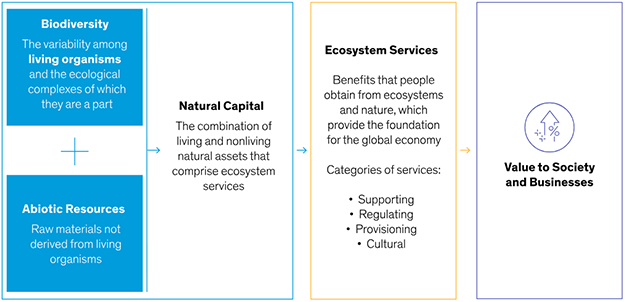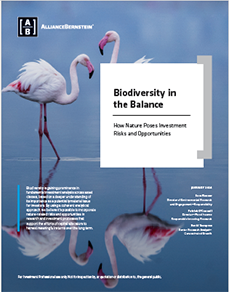AllianceBernstein - Biodiversity in the Balance
How Nature Poses Investment Risks and Opportunities

What You Need to Know
Biodiversity is gaining prominence in fundamental investment analysis across asset classes, based on a deeper understanding of its importance as a potentially material issue for investors. By using a coherent analytical approach, we believe it’s possible to incorporate nature-related risks and opportunities in research and investment processes that support the efforts of capital allocators to harvest meaningful returns over time.
30% of the world’s lands, inland waters, coastal areas and oceans targeted for conservation and management by 2030, under the UN’s Global Biodiversity Framework.
US$722 billion ‒ US$967 billion estimated annual shortfall in the financing needed to reverse biodiversity loss by 2030. [1]
US$10.1 trillion Annual business value that could be created by nature-positive actions in food, land and ocean use by 2030. [2]
From South Africa’s endangered black rhinoceros to the shrinking Amazon rainforest, threats to the variability of life on Earth are mounting. Protecting biodiversity—animals, plants and other living organisms, and the ecosystems they are part of—is vital to maintain the health of our planet and the products, services and economic activity that sustain our daily life. Yet until recently, biodiversity hasn’t ranked highly among investors’ priorities.
This may seem surprising, given biodiversity’s importance as the living component of the natural world. Together with abiotic resources—the nonliving components of the natural world, such as land, water, air and minerals—biodiversity comprises natural capital, the world’s stock of natural assets. Natural capital provides the building blocks that enable ecosystem services—the positive benefits that societies and economies derive from nature—to sustain life and create wealth (Display).
Biodiversity and Nature
The Building Blocks That Sustain Life and Economic Activity

Source: Integrating Biodiversity into Natural Capital Assessments, Capitals Coalition and Cambridge Conservation Initiative, 2020; Biodiversity Resource Guide, AllianceBernstein (AB), August 2022.
Gaining Prominence in Investment Analysis
Consequently, biodiversity is gaining prominence in fundamental investment analysis across asset classes, based on a deeper understanding of its importance as a potentially material risk and opportunity for investors. Nature-related risks are defined by the Taskforce on Nature-related Financial Disclosures (TNFD) as the potential short- and long-term threats posed to an organization linked to its direct, upstream, and downstream dependencies and impact on nature.
With resources becoming scarcer, the human population growing and regulatory activity increasing, investors must be able to make informed judgments about how companies are exposed to the causes and effects of biodiversity loss—and to the opportunities that may arise from attempting to mitigate this loss. Depending on how these risks are managed, they could hurt portfolio valuations or be the basis for new investment opportunities. By using a coherent analytical approach, we believe it’s possible to invest in a way that’s more aligned with biodiversity and that supports the efforts of capital allocators to harvest meaningful returns over the long term.
Growing Focus on Biodiversity to Create Opportunities
This paper provides a comprehensive survey of biodiversity for investors. Our report defines biodiversity and presents the scale of its global economic impact. We discuss the regulatory frameworks that are pushing biodiversity onto the global investment agenda as well as the nature-related business and investment risks that deserve closer attention.
The growing focus on biodiversity will also create economic and investment opportunities. We illustrate this through case studies and provide a conceptual framework to help investors map out biodiversity risk across sectors and companies. Finally, we discuss what we’re doing at AB to begin incorporating biodiversity considerations across the firm.

Download the PDF version here.
[1] Financing Nature: Closing the Global Biodiversity Financing Gap, Paulson Institute, The Nature Conservancy and Cornell Atkinson Center for Sustainability, 2020, 14
[2] New Nature Economy Report II, The Future of Nature and Business, World Economic Forum and AlphaBeta, 2020, 4
Important Information:
For investment professional use only. Not for inspection by, distribution or quotation to, the general public.
The views expressed herein do not constitute research, investment advice or trade recommendations and do not necessarily represent the views of all AB portfolio-management teams. Views are subject to change over time.
July 2025
Please note that these are the views of AllianceBernstein and should not be interpreted as the views of RL360.